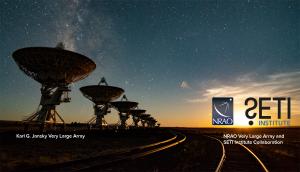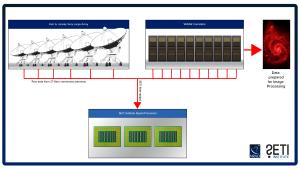Blog
Doing SETI While
Doing Science
18 February 2020
 Bill Saxton, NRAO/AUI/NSF
Bill Saxton, NRAO/AUI/NSFIs there intelligent life in the universe? There are only two possible answers to this question. Either Earth is the only planet with sentient life in the cosmos, or there are other civilizations out there waiting to be discovered. Either answer is profound.
In 1984 the SETI Institute was founded to answer this question. The privately-funded organization has undertaken numerous research studies, trying to find a signal from aliens. While some have seen the project as a bit fringe, there is quite a bit of evidence to support the idea of life on other worlds. It’s estimated that there are more than 10 billion potentially habitable planets in the Milky Way alone. Life appeared on Earth early in its geological history, and it’s not unreasonable to assume life would arise on at least some exoplanets.
But so far the search for aliens has turned up nothing. Not a single radio blip. No booming message from another star. This poses quite a challenge for a project like SETI. On the one hand, evidence of alien civilizations would be one of the greatest discoveries in human history. On the other hand, why take up valuable telescope time on a project that is such a long shot?
 Bill Saxton, NRAO/AUI/NSF
Bill Saxton, NRAO/AUI/NSFBut a new agreement between SETI and the Very Large Array (VLA) could give us the best of both worlds. While projects such as Breakthrough Listen either buy time on radio telescopes or use detected telescopes in the search for aliens, the SETI/VLA project combines missions. The idea is for SETI to build a specialized data processing computer that could be tied into the correlator system of the VLA. While the VLA goes about its regular scientific observations, the data it gathers would be sent to both the VLA system and SETI’s system. The VLA can undertake research as normal, and SETI gets to sift through the data for evidence of extraterrestrial life.
While the project is still in the early planning stage, it’s an idea that could be extended to other observatories. There is still much to learn about the cosmos. As we strive to understand more, SETI can seek to answer one of humanity’s deepest mysteries.
Disclaimer: I currently work for NRAO, which manages and operates the VLA.